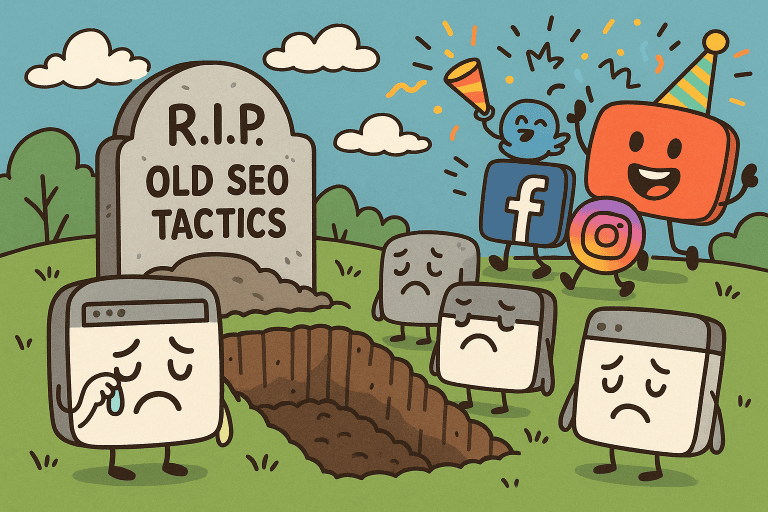Here we go again. Google’s feeding us a line, claiming their AI Overviews (that thing popping up in search results) actually help drive clicks. Yeah, right! Folks have already done the math – seeing drops like 34% in clicks, thank you very much. Bottom line, for anyone who hasn’t caught on: good old SEO isn’t working like it used to. The game has changed, you gotta adapt, or you’ll get left behind.
So, what now? The buzz is all about “omnipresent SEO.” Meaning, stop obsessing only over your little website. Sure, it’s important, like your foundation, but it can’t fight the battle solo anymore. Picture this: for a crucial keyword, the AI Overview features someone’s YouTube video first, not your perfectly crafted blog post! That kinda hints that your website alone isn’t gonna cut it.
Stop Obsessing Over Just Your Site: Be Everywhere
You gotta be everywhere. YouTube (long videos, Shorts – whatever floats your boat, as long as it’s relevant; Google loves and indexes that stuff), LinkedIn (if that’s your jam), all those other social media spots. Basically, actively push out relevant content everywhere you possibly can. And yeah, don’t forget paid ads – grab another spot on the SERP, throw some fuel on the fire, so to speak. If you’ve only got one measly link showing up on page one, you’re at a massive disadvantage. Your odds aren’t great.
Rethink Your Content: Start Where the Money Is
And here’s the kicker – change your whole approach to content. Stop chasing those high-volume, pie-in-the-sky keywords like “what is SEO.” AI can spit that generic info out in a second, and honestly, those terms rarely convert anyway. You gotta think! Start at the bottom of the funnel – where the money is. Think queries like “[Brand Name] pricing,” “[Brand Name] reviews,” “[Brand Name] vs. Competitor X.” Yeah, the traffic volume is lower, but these are people with their wallets half-open, ready to buy. That’s who you build dedicated landing pages, case studies, comparisons, and reviews for.
“But my brand is new, nobody searches for that yet!” Look at your competitors! Check out what people search for established players like HubSpot – terms like “HubSpot pricing,” “HubSpot alternatives.” Then, create that same kind of content for your brand in advance! So when people do start searching, boom, you’re already there waiting for them.
Next, move a bit higher up the funnel – terms like “best content optimization tools,” “how to optimize blog post for SEO.” People searching for this aren’t ready to buy your software yet. Here, you offer them a lead magnet – a checklist, a template, something useful. Free, of course, just swap it for their email. Make absolutely sure the lead magnet actually delivers a small win, a little “aha!” moment. That builds trust. And hey, inside that freebie? Casually mention your product. Then what? Nurture those leads via email. Don’t just spam them with sales pitches; send links to your other helpful content (articles, videos) that guides them further down the funnel. Gently pull them along.
As for the very top of the funnel – super broad stuff like “what is SEO content”? Honestly, you can probably just ignore that for now. You’ve got more than enough work to do on the lower, money-making levels.
Don’t Build on Rented Land: Own Your Assets & Use Google’s Tools
Another crucial point: platforms. Remember this: Your website and your email list are the only digital assets you truly own. YouTube, Facebook, LinkedIn, TikTok – that’s all rented land. One algorithm change, one policy update, one random ban, and poof – you’re gone. Kaput. So, every piece of content you put on those “rented” platforms needs one primary goal: drive people back to your turf – your website, your email list sign-up. Otherwise, it’s mostly just busywork (unless you’re solely aiming to be an influencer, which is a different game). By the way, this strategy also fuels branded search – people see your killer video on YouTube, then they Google your brand name, and land on your site already warmed up and interested.
Oh yeah, and links! Backlinks still matter. Not just for Google’s crawlers, but for feeding those hungry AIs like ChatGPT too. So don’t sleep on building good links.
And seriously, don’t forget your Google Business Profile! If you don’t have one optimized, you’re seriously leaving money on the table. It’s free real estate right there on the search results page, complete with reviews, photos, directions, the whole nine yards. Someone Googles you, sees a polished profile packed with positive reviews – they’re practically sold before they even click through to your site. Google loves its own products (Search, YouTube, GBP), so you gotta milk them for all they’re worth.
So, the TL;DR? Relying only on traditional SEO won’t cut it anymore. You need to be a marketing Swiss Army knife now. Churn out valuable content everywhere, across all relevant platforms, targeting different stages of the buyer’s journey (starting from the bottom!). Build an integrated system where your website, YouTube channel, social media presence, email marketing, and paid ads all work together seamlessly.
Otherwise? You might as well just sit back and watch the world go by. That’s the deal.




